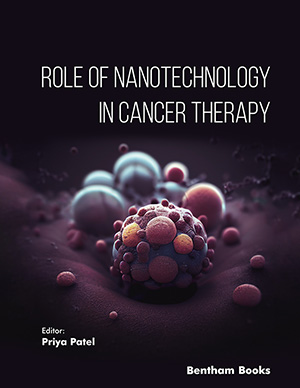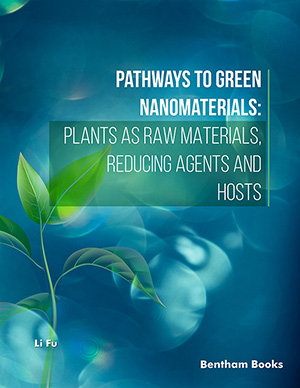Abstract
Copper (Cu) has been used in agriculture for centuries as a standard bactericide/fungicide due to its low cost, superior disease control efficacy, and relatively low toxicity to humans. However, the extensive use of copper as a pesticide has caused the development of Cu-tolerant microorganisms as well as negative environmental impacts due to the accumulation of copper in soil and bodies of water. Therefore, there is a strong demand for advanced Cu products and alternatives to minimize the Cu footprint in the environment. This minireview will cover the limitations of Cu usage and the strategies being investigated to develop advanced Cu materials and alternatives for crop protection using nanotechnology.
Keywords: Nanoparticle, nanopesticide, copper, quat, magnesium, zinc, bactericide, fungicide, sulfur.
[http://dx.doi.org/10.1016/B978-0-12-804299-1.00007-2]
[http://dx.doi.org/10.1007/s10311-020-01155-x]
[http://dx.doi.org/10.1021/acs.jafc.7b00516] [PMID: 28252293]
[http://dx.doi.org/10.1007/s13593-018-0503-9]
[http://dx.doi.org/10.1038/s41598-019-56419-6]
[http://dx.doi.org/10.1016/j.cropro.2017.02.008]
[http://dx.doi.org/10.1073/pnas.88.20.8915] [PMID: 1924351]
[http://dx.doi.org/10.1128/jb.170.6.2879-2883.1988] [PMID: 3372485]
[http://dx.doi.org/10.1099/mic.0.2007/013821-0] [PMID: 18227244]
[http://dx.doi.org/10.1128/aem.59.5.1627-1634.1993] [PMID: 16348942]
[http://dx.doi.org/10.1111/j.1574-6976.1994.tb00083.x] [PMID: 8049096]
[http://dx.doi.org/10.1007/s10565-013-9262-1] [PMID: 24072389]
[http://dx.doi.org/10.3389/fmicb.2018.03272] [PMID: 30687263]
[http://dx.doi.org/10.1007/s00248-011-9861-4] [PMID: 21553058]
[http://dx.doi.org/10.1016/j.mib.2017.03.008] [PMID: 28433932]
[http://dx.doi.org/10.1007/s12011-011-9228-1] [PMID: 22002857]
[http://dx.doi.org/10.1007/s11104-013-1886-7]
[http://dx.doi.org/10.1007/s00128-005-0852-3] [PMID: 16400594]
[http://dx.doi.org/10.1016/S0300-483X(03)00159-8] [PMID: 12821289]
[http://dx.doi.org/10.1016/j.ecoenv.2011.05.018] [PMID: 21700338]
[http://dx.doi.org/10.1039/C6EN00146G]
[http://dx.doi.org/10.1094/PDIS-10-17-1621-RE] [PMID: 30673561]
[http://dx.doi.org/10.1021/acssuschemeng.8b03379]
[http://dx.doi.org/10.1021/acssuschemeng.9b01433]
[http://dx.doi.org/10.1007/s13204-017-0606-7]
[http://dx.doi.org/10.1039/D0EN00535E]
[http://dx.doi.org/10.1016/j.foodhyd.2019.02.034]
[http://dx.doi.org/10.1039/D0RA02050H]
[http://dx.doi.org/10.1166/jbn.2012.1423] [PMID: 22852465]
[http://dx.doi.org/10.1021/jf502350w] [PMID: 24911959]
[http://dx.doi.org/10.1094/PHYTO-06-17-0221-R] [PMID: 28990482]
[http://dx.doi.org/10.1016/j.cropro.2020.105366]
[http://dx.doi.org/10.1021/acs.jafc.7b02526] [PMID: 28832140]
[http://dx.doi.org/10.1039/D0NA00917B]
[http://dx.doi.org/10.1038/s41598-019-54678-x]
[http://dx.doi.org/10.1038/s41565-020-00812-0] [PMID: 33318639]
[http://dx.doi.org/10.1071/EN18279]
[http://dx.doi.org/10.1016/j.ijbiomac.2015.01.027] [PMID: 25617841]
[http://dx.doi.org/10.1021/acs.jafc.6b02239] [PMID: 27460439]
[http://dx.doi.org/10.1021/acsnano.1c02917]
[http://dx.doi.org/10.1002/app.31249]
[http://dx.doi.org/10.1039/D1NR02459K] [PMID: 34105578]
[http://dx.doi.org/10.1039/D0BM01398F] [PMID: 33084664]
[http://dx.doi.org/10.1021/nn4034794] [PMID: 24016217]
[http://dx.doi.org/10.1094/PDIS-05-15-0580-RE] [PMID: 30686188]
[http://dx.doi.org/10.1007/s42161-019-00478-1]
[http://dx.doi.org/10.1016/j.jhazmat.2013.10.053] [PMID: 24275476]
[http://dx.doi.org/10.1016/j.envpol.2017.05.083] [PMID: 28582676]
[http://dx.doi.org/10.1039/D0EN00757A]
[http://dx.doi.org/10.1039/D0EN00387E]
[http://dx.doi.org/10.1016/j.enmm.2020.100355]
[http://dx.doi.org/10.1039/C9RA05843E]
[http://dx.doi.org/10.1007/s10876-021-02048-x]
[http://dx.doi.org/10.1071/EN19254]
[http://dx.doi.org/10.1094/PDIS-05-16-0598-RE] [PMID: 30686171]
[http://dx.doi.org/10.1371/journal.pone.0204702] [PMID: 30304000]
[http://dx.doi.org/10.1016/j.scitotenv.2019.03.210] [PMID: 30903901]
[http://dx.doi.org/10.1111/ppa.12443]
[http://dx.doi.org/10.1038/s41598-019-54717-7] [PMID: 31811183]
[http://dx.doi.org/10.1021/acs.jafc.8b01727] [PMID: 30025447]
[http://dx.doi.org/10.1016/j.colsurfb.2010.10.027] [PMID: 21115282]
[http://dx.doi.org/10.1021/bm301108x] [PMID: 22998760]
[http://dx.doi.org/10.1021/acs.jafc.8b04189] [PMID: 30511854]
[http://dx.doi.org/10.1007/s00253-011-3142-5] [PMID: 21350853]
[http://dx.doi.org/10.1093/jac/dkr591] [PMID: 22269475]
[http://dx.doi.org/10.1039/c3ra40500a]
[http://dx.doi.org/10.1016/j.msec.2018.07.015] [PMID: 30184776]
[http://dx.doi.org/10.1016/j.foodhyd.2018.03.054]
[http://dx.doi.org/10.1016/j.carbpol.2019.115191]
[http://dx.doi.org/10.1016/j.micpath.2020.104178] [PMID: 32240768]
[http://dx.doi.org/10.1021/acs.est.8b02111] [PMID: 30078329]



























